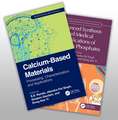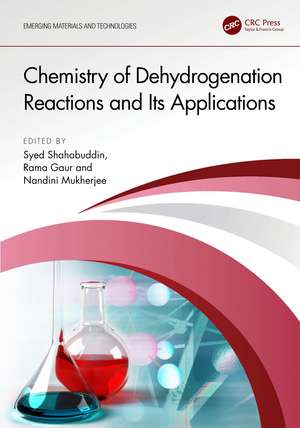Chemistry of Dehydrogenation Reactions and Its Applications: Emerging Materials and Technologies
Editat de Syed Shahabuddin, Rama Gaur, Nandini Mukherjeeen Limba Engleză Hardback – 21 feb 2024
Features:
- Offers a wide overview of dehydrogenation catalytic chemistry catalyzed by transition metals and their compounds.
- Helps design novel and more benign and uncomplicated protocols for the synthesis of valuable chemicals from readily available raw materials.
- Provides deeper insight into the aspect of dehydrogenation reactions for clean chemical synthesis via a cascade process.
- Summarizes new mechanistic details of dehydrogenation reactions, experimental side development and applications of dehydrogenation techniques.
- Explores alternative solutions for the assimilation and transportation of clean energy in the form of hydrogen energy utilization.
Din seria Emerging Materials and Technologies
- 9%
 Preț: 763.94 lei
Preț: 763.94 lei -
 Preț: 377.23 lei
Preț: 377.23 lei -
 Preț: 358.41 lei
Preț: 358.41 lei - 9%
 Preț: 766.45 lei
Preț: 766.45 lei - 9%
 Preț: 639.75 lei
Preț: 639.75 lei -
 Preț: 381.33 lei
Preț: 381.33 lei - 9%
 Preț: 641.14 lei
Preț: 641.14 lei - 9%
 Preț: 693.79 lei
Preț: 693.79 lei - 9%
 Preț: 763.91 lei
Preț: 763.91 lei - 9%
 Preț: 937.19 lei
Preț: 937.19 lei - 9%
 Preț: 728.67 lei
Preț: 728.67 lei - 9%
 Preț: 1727.63 lei
Preț: 1727.63 lei - 9%
 Preț: 832.36 lei
Preț: 832.36 lei - 9%
 Preț: 696.28 lei
Preț: 696.28 lei - 18%
 Preț: 1119.75 lei
Preț: 1119.75 lei - 18%
 Preț: 782.74 lei
Preț: 782.74 lei - 18%
 Preț: 1000.27 lei
Preț: 1000.27 lei - 18%
 Preț: 1004.20 lei
Preț: 1004.20 lei - 18%
 Preț: 903.67 lei
Preț: 903.67 lei - 18%
 Preț: 1120.55 lei
Preț: 1120.55 lei - 18%
 Preț: 902.42 lei
Preț: 902.42 lei - 25%
 Preț: 710.83 lei
Preț: 710.83 lei - 18%
 Preț: 896.13 lei
Preț: 896.13 lei - 18%
 Preț: 1061.22 lei
Preț: 1061.22 lei - 18%
 Preț: 779.13 lei
Preț: 779.13 lei - 18%
 Preț: 895.46 lei
Preț: 895.46 lei - 18%
 Preț: 781.28 lei
Preț: 781.28 lei - 15%
 Preț: 697.85 lei
Preț: 697.85 lei - 28%
 Preț: 717.31 lei
Preț: 717.31 lei - 18%
 Preț: 909.01 lei
Preț: 909.01 lei - 9%
 Preț: 1009.04 lei
Preț: 1009.04 lei - 18%
 Preț: 782.44 lei
Preț: 782.44 lei - 18%
 Preț: 1000.89 lei
Preț: 1000.89 lei - 18%
 Preț: 1058.34 lei
Preț: 1058.34 lei - 18%
 Preț: 1062.62 lei
Preț: 1062.62 lei - 18%
 Preț: 836.77 lei
Preț: 836.77 lei - 18%
 Preț: 897.70 lei
Preț: 897.70 lei - 20%
 Preț: 886.55 lei
Preț: 886.55 lei - 9%
 Preț: 937.14 lei
Preț: 937.14 lei - 18%
 Preț: 844.97 lei
Preț: 844.97 lei - 18%
 Preț: 1059.14 lei
Preț: 1059.14 lei - 15%
 Preț: 566.19 lei
Preț: 566.19 lei - 18%
 Preț: 887.43 lei
Preț: 887.43 lei - 18%
 Preț: 892.48 lei
Preț: 892.48 lei - 18%
 Preț: 890.59 lei
Preț: 890.59 lei - 18%
 Preț: 838.18 lei
Preț: 838.18 lei - 18%
 Preț: 1057.26 lei
Preț: 1057.26 lei - 9%
 Preț: 1075.57 lei
Preț: 1075.57 lei - 26%
 Preț: 522.74 lei
Preț: 522.74 lei
Preț: 1281.07 lei
Preț vechi: 1562.28 lei
-18% Nou
Puncte Express: 1922
Preț estimativ în valută:
245.14€ • 262.13$ • 204.39£
245.14€ • 262.13$ • 204.39£
Carte tipărită la comandă
Livrare economică 17 aprilie-01 mai
Preluare comenzi: 021 569.72.76
Specificații
ISBN-13: 9781032343969
ISBN-10: 1032343966
Pagini: 292
Ilustrații: 22 Tables, black and white; 280 Line drawings, black and white; 1 Halftones, black and white; 281 Illustrations, black and white
Dimensiuni: 178 x 254 x 18 mm
Greutate: 0.7 kg
Ediția:1
Editura: CRC Press
Colecția CRC Press
Seria Emerging Materials and Technologies
ISBN-10: 1032343966
Pagini: 292
Ilustrații: 22 Tables, black and white; 280 Line drawings, black and white; 1 Halftones, black and white; 281 Illustrations, black and white
Dimensiuni: 178 x 254 x 18 mm
Greutate: 0.7 kg
Ediția:1
Editura: CRC Press
Colecția CRC Press
Seria Emerging Materials and Technologies
Public țintă
AcademicCuprins
Chapter 1 Introduction to Dehydrogenation Reactions of Organic Compounds
Chapter 2 Transition Metal-Based Catalyst for Dehydrogenation Reactions of Organic Compounds
Chapter 3 Transition Metal Catalyst Free Dehydrogenative Organic Synthesis: Role of New Materials, Composites, and Nanomaterials
Chapter 4 Dehydrogenation Reaction of Aliphatic and Aromatic Alcohols
Chapter 5 Dehydrogenation Reactions of Hydrocarbons: Alkane, Alkenes, and Aromatic Hydrocarbons
Chapter 6 Dehydrogenation Reactions of Aliphatic and Aromatic Amines
Chapter 7 Dehydrogenation Reactions of Aliphatic and Aromatic Carboxylic Acids and Their Derivatives
Chapter 8 Dehydrogenation Reactions of Heterocyclic Compounds and Their Derivatives
Chapter 9 Recent Advances in Dehydrogenative Technique for Hydrogen Energy Storage and Utilization
Chapter 10 Dehydrogenation Reactions and Inspirations from Nature for the Synthesis of Building Blocks Leading to Valued Pharmaceutical Compounds
Chapter 11 Industrial Applications of Dehydrogenation Reactions: Process Design of Reactors
Chapter 12 Future Aspects of Dehydrogenation Reactions
Chapter 13 Utilizing Ruthenium (Ru) Complexes in Dehydration Reactions of Saturated and Unsaturated Compounds
Chapter 14 Dehydrogenation Reactions Incorporating Membrane Catalysis
Chapter 15 A Greener Dehydrogenation: Environmentally Benign Reactions
Chapter 16 Application of Pt- and Non Pt-Based Zeolitic Catalysts for Dehydrogenation of Light Alkanes
Chapter 17 Porous Nanomaterials as Heterogeneous Catalysts for the Dehydrogenation of Paraffin
Chapter 2 Transition Metal-Based Catalyst for Dehydrogenation Reactions of Organic Compounds
Chapter 3 Transition Metal Catalyst Free Dehydrogenative Organic Synthesis: Role of New Materials, Composites, and Nanomaterials
Chapter 4 Dehydrogenation Reaction of Aliphatic and Aromatic Alcohols
Chapter 5 Dehydrogenation Reactions of Hydrocarbons: Alkane, Alkenes, and Aromatic Hydrocarbons
Chapter 6 Dehydrogenation Reactions of Aliphatic and Aromatic Amines
Chapter 7 Dehydrogenation Reactions of Aliphatic and Aromatic Carboxylic Acids and Their Derivatives
Chapter 8 Dehydrogenation Reactions of Heterocyclic Compounds and Their Derivatives
Chapter 9 Recent Advances in Dehydrogenative Technique for Hydrogen Energy Storage and Utilization
Chapter 10 Dehydrogenation Reactions and Inspirations from Nature for the Synthesis of Building Blocks Leading to Valued Pharmaceutical Compounds
Chapter 11 Industrial Applications of Dehydrogenation Reactions: Process Design of Reactors
Chapter 12 Future Aspects of Dehydrogenation Reactions
Chapter 13 Utilizing Ruthenium (Ru) Complexes in Dehydration Reactions of Saturated and Unsaturated Compounds
Chapter 14 Dehydrogenation Reactions Incorporating Membrane Catalysis
Chapter 15 A Greener Dehydrogenation: Environmentally Benign Reactions
Chapter 16 Application of Pt- and Non Pt-Based Zeolitic Catalysts for Dehydrogenation of Light Alkanes
Chapter 17 Porous Nanomaterials as Heterogeneous Catalysts for the Dehydrogenation of Paraffin
Notă biografică
Dr. Syed Shahabuddin obtained his M.Sc. in materials chemistry in 2011 from Jamia Millia Islamia, India. He was awarded a Ph.D. in polymer chemistry from the University of Malaya, Malaysia in September 2016. He has served as Assistant Manager in Samtel Avionics Limited for almost three years in research and development of avionics grade displays. Formerly, he has worked as a Senior Research Fellow (senior lecture) at Research Centre for Nano-Materials and Energy Technology (RCNMET), Sunway University, Malaysia for more than 2 years. Currently, he is working as an assistant professor in Pandit Deendayal Petroleum University, Gandhinagar, and Gujrat. He has published more than 120 research articles in International journals of repute and presented 30 papers in International/National conferences. He has successfully completed two research project as PI and two research project as CO-I whereas he is currently Co-I for 8 running projects with different institutes in Malaysia. He is the member of Royal Society of Chemistry (MRSC) and reviewer of many high impact journals. His current research focus on the synthesis of Nanomaterials, 2D-MXene, Graphene, conducting polymer nanocomposites for water treatment, photocatalysis, supercapacitors, DSSCs, nanofluids for solar thermal applications, waste lubricant oil refining and phase change materials.
Dr. Rama Gaur is Assistant Professor, School of Technology, PDPU Gandhinagar, Gujarat. She received her Ph.D. in chemistry from IIT Roorkee in 2017. Dr. Gaur has expertise in the synthesis of nanoscale materials with interesting and unique morphologies through simple and economical chemical approaches; shape and size dependent optical, magnetic and electrochemical properties; applications in photocatalysis, optoelectronics, electrochemical sensing, electrocatalytic reduction/oxidation, solar energy conversion, energy storage devices, supercapacitors, water splitting and environmental remediation. Dr. Gaur has recently received research grant for DST-SERB-TARE Grant in collaboration with IIT Gandhinagar. Dr. Gaur has served as Assistant Professor at National Institute of Technology Hamirpur and Indian Institute of Information Technology, Una (Himachal Pradesh). She has vast experience in teaching and research.
Dr. Nandini Mukherjee completed her bachelor's (B.Sc. Hons.) in chemistry from Scottish Church College, University of Calcutta in 2012 and master's in chemistry from Banaras Hindu University in 2014. She received her Ph.D. in bioinorganic and medicinal chemistry from the Indian Institute of Science, Bangalore in 2020. Currently, she is working as Assistant Professor in the Department of Chemistry, Pandit Deendayal Energy University (PDEU), Gandhinagar, Gujarat. Prior to joining PDEU she has also worked as a research associate in IISc Bangalore. She has more than 5 years of research experience in organic synthesis and coordination chemistry and published her research in international peer-reviewed journals. Her current research interest focuses on the design and synthesis of molecules that have applications in the field of chemo-sensing of toxins and monitoring biological phenomena; She is also working to develop cost-effective nanomaterials for application in medicinal chemistry and the renewable energy sector.
Dr. Rama Gaur is Assistant Professor, School of Technology, PDPU Gandhinagar, Gujarat. She received her Ph.D. in chemistry from IIT Roorkee in 2017. Dr. Gaur has expertise in the synthesis of nanoscale materials with interesting and unique morphologies through simple and economical chemical approaches; shape and size dependent optical, magnetic and electrochemical properties; applications in photocatalysis, optoelectronics, electrochemical sensing, electrocatalytic reduction/oxidation, solar energy conversion, energy storage devices, supercapacitors, water splitting and environmental remediation. Dr. Gaur has recently received research grant for DST-SERB-TARE Grant in collaboration with IIT Gandhinagar. Dr. Gaur has served as Assistant Professor at National Institute of Technology Hamirpur and Indian Institute of Information Technology, Una (Himachal Pradesh). She has vast experience in teaching and research.
Dr. Nandini Mukherjee completed her bachelor's (B.Sc. Hons.) in chemistry from Scottish Church College, University of Calcutta in 2012 and master's in chemistry from Banaras Hindu University in 2014. She received her Ph.D. in bioinorganic and medicinal chemistry from the Indian Institute of Science, Bangalore in 2020. Currently, she is working as Assistant Professor in the Department of Chemistry, Pandit Deendayal Energy University (PDEU), Gandhinagar, Gujarat. Prior to joining PDEU she has also worked as a research associate in IISc Bangalore. She has more than 5 years of research experience in organic synthesis and coordination chemistry and published her research in international peer-reviewed journals. Her current research interest focuses on the design and synthesis of molecules that have applications in the field of chemo-sensing of toxins and monitoring biological phenomena; She is also working to develop cost-effective nanomaterials for application in medicinal chemistry and the renewable energy sector.
Descriere
The present book focuses on the application of heterogeneous catalytic materials for the dehydrogenative synthesis of valuable organic compounds from substrates like alcohols and simple aliphatic compounds. Heterogeneous transition metals based catalytic materials are explored for the synthesis of chemicals for the industrial applications.
